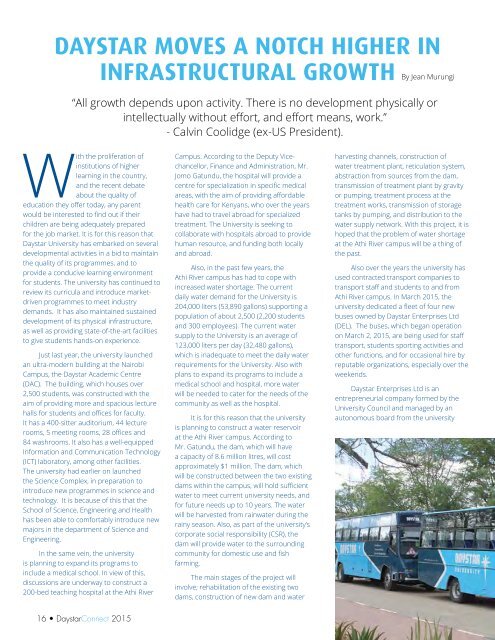our roots
Connect2015
Connect2015
Create successful ePaper yourself
Turn your PDF publications into a flip-book with our unique Google optimized e-Paper software.
Daystar moves a notch higher in<br />
infrastructural growth<br />
By Jean Murungi<br />
“All growth depends upon activity. There is no development physically or<br />
intellectually without effort, and effort means, work.”<br />
- Calvin Coolidge (ex-US President).<br />
With the proliferation of<br />
institutions of higher<br />
learning in the country,<br />
and the recent debate<br />
about the quality of<br />
education they offer today, any parent<br />
would be interested to find out if their<br />
children are being adequately prepared<br />
for the job market. It is for this reason that<br />
Daystar University has embarked on several<br />
developmental activities in a bid to maintain<br />
the quality of its programmes, and to<br />
provide a conducive learning environment<br />
for students. The university has continued to<br />
review its curricula and introduce marketdriven<br />
programmes to meet industry<br />
demands. It has also maintained sustained<br />
development of its physical infrastructure,<br />
as well as providing state-of-the-art facilities<br />
to give students hands-on experience.<br />
Just last year, the university launched<br />
an ultra-modern building at the Nairobi<br />
Campus, the Daystar Academic Centre<br />
(DAC). The building, which houses over<br />
2,500 students, was constructed with the<br />
aim of providing more and spacious lecture<br />
halls for students and offices for faculty.<br />
It has a 400-sitter auditorium, 44 lecture<br />
rooms, 5 meeting rooms, 28 offices and<br />
84 washrooms. It also has a well-equipped<br />
Information and Communication Technology<br />
(ICT) laboratory, among other facilities.<br />
The university had earlier on launched<br />
the Science Complex, in preparation to<br />
introduce new programmes in science and<br />
technology. It is because of this that the<br />
School of Science, Engineering and Health<br />
has been able to comfortably introduce new<br />
majors in the department of Science and<br />
Engineering.<br />
In the same vein, the university<br />
is planning to expand its programs to<br />
include a medical school. In view of this,<br />
discussions are underway to construct a<br />
200-bed teaching hospital at the Athi River<br />
Campus. According to the Deputy Vicechancellor,<br />
Finance and Administration, Mr.<br />
Jomo Gatundu, the hospital will provide a<br />
centre for specialization in specific medical<br />
areas, with the aim of providing affordable<br />
health care for Kenyans, who over the years<br />
have had to travel abroad for specialized<br />
treatment. The University is seeking to<br />
collaborate with hospitals abroad to provide<br />
human res<strong>our</strong>ce, and funding both locally<br />
and abroad.<br />
Also, in the past few years, the<br />
Athi River campus has had to cope with<br />
increased water shortage. The current<br />
daily water demand for the University is<br />
204,000 liters (53,890 gallons) supporting a<br />
population of about 2,500 (2,200 students<br />
and 300 employees). The current water<br />
supply to the University is an average of<br />
123,000 liters per day (32,480 gallons),<br />
which is inadequate to meet the daily water<br />
requirements for the University. Also with<br />
plans to expand its programs to include a<br />
medical school and hospital, more water<br />
will be needed to cater for the needs of the<br />
community as well as the hospital.<br />
It is for this reason that the university<br />
is planning to construct a water reservoir<br />
at the Athi River campus. According to<br />
Mr. Gatundu, the dam, which will have<br />
a capacity of 8.6 million litres, will cost<br />
approximately $1 million. The dam, which<br />
will be constructed between the two existing<br />
dams within the campus, will hold sufficient<br />
water to meet current university needs, and<br />
for future needs up to 10 years. The water<br />
will be harvested from rainwater during the<br />
rainy season. Also, as part of the university’s<br />
corporate social responsibility (CSR), the<br />
dam will provide water to the surrounding<br />
community for domestic use and fish<br />
farming.<br />
The main stages of the project will<br />
involve; rehabilitation of the existing two<br />
dams, construction of new dam and water<br />
harvesting channels, construction of<br />
water treatment plant, reticulation system,<br />
abstraction from s<strong>our</strong>ces from the dam,<br />
transmission of treatment plant by gravity<br />
or pumping, treatment process at the<br />
treatment works, transmission of storage<br />
tanks by pumping, and distribution to the<br />
water supply network. With this project, it is<br />
hoped that the problem of water shortage<br />
at the Athi River campus will be a thing of<br />
the past.<br />
Also over the years the university has<br />
used contracted transport companies to<br />
transport staff and students to and from<br />
Athi River campus. In March 2015, the<br />
university dedicated a fleet of f<strong>our</strong> new<br />
buses owned by Daystar Enterprises Ltd<br />
(DEL). The buses, which began operation<br />
on March 2, 2015, are being used for staff<br />
transport, students sporting activities and<br />
other functions, and for occasional hire by<br />
reputable organizations, especially over the<br />
weekends.<br />
Daystar Enterprises Ltd is an<br />
entrepreneurial company formed by the<br />
University Council and managed by an<br />
autonomous board from the university<br />
16 • DaystarConnect 2015


